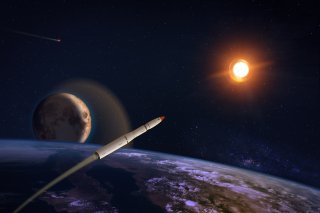Pyongyang Goes Nuclear—This Time in Space
A war game conducted by the Nonproliferation Policy Education Center raises questions about how the United States could respond to a North Korean nuclear detonation... in space.
3. To hedge against possible nuclear attacks against low-Earth orbiting systems, the United States and its space-faring allies should develop alternatives both in other space orbits and on and near Earth.
Devising space systems that can operate in several different orbits without major modifications and without dramatically increasing costs would be extremely useful to cope with the threats posed in the game. Such systems could afford the United States and its allies much greater levels of space system resiliency against both nuclear and nonnuclear threats. Such systems would also allow much greater operational flexibility in determining what an “optimal” constellation might be. Finally, it would make any reconstitution efforts much quicker and, possibly cheaper.
Meanwhile, on and near Earth, it would be useful to fortify land and sea cable communication systems, ground-based navigational aids, and the development of alternative imagery systems mated to high-altitude balloons, drones, or other non-space platforms. These land and air-based systems could be useful as stop gaps if low-Earth orbit space systems are disabled. In developing these alternative systems, it would be useful to develop ways to defend them both passively and actively.
4. Two large unknowns worth cracking are how feasible it might be to verify the presence of nuclear weapons in space and what proportionate military action might be to a nuclear detonation there and in near-space.
There was considerable debate about America’s ability to verify a nuclear payload in space. Some thought it would be possible eventually; others were skeptical. Several questioned even with a large fleet of such inspection systems constantly in orbit along with space systems to neutralize such payloads, if one could ever get close enough soon enough to make any difference.
Whatever the truth may be, it is critical to determine what’s possible so that reasonable expectations can be set before a crisis might occur. It is always tempting to spend significant amounts of time and money to try to secure a technical fix to such a challenging detection mission. But in this case, it may make more sense, however, to design technically and militarily around the probability that such a fix is unlikely.
Yet another mistaken assumption the game revealed was that effective, proportionate military counterstrike options to a nuclear detonation in space are readily on tap. In the game, they were not; in reality, they probably aren’t either. Again, it is unclear if such options ever will be. This “hunch,” however, needs to be assessed.
Satellites as Hostages?
Again, some might dismiss this game and its findings as outliers. To do so though—as America and its allies rely ever more on low-Earth orbiting satellites to accomplish military and commercial missions—would be a mistake. Indeed, it could prove fatal, as our adversaries develop new ways to hold these satellites at risk.
Henry Sokolski, executive director of the Nonproliferation Policy Education Center, served as deputy for nonproliferation in the Defense Department and is the author of Underestimated: Our Not So Peaceful Nuclear Future (2019).
Image: Maxal Tamor/Shutterstock.

